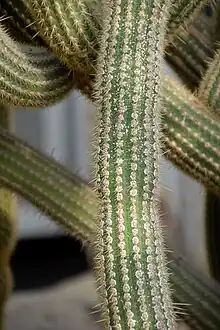Cleistocactus luribayensis
Cleistocactus luribayensis is a species of columnar cacti in the genus Cleistocactus.
| Cleistocactus luribayensis | |
|---|---|
 | |
| Scientific classification | |
| Kingdom: | Plantae |
| Clade: | Tracheophytes |
| Clade: | Angiosperms |
| Clade: | Eudicots |
| Order: | Caryophyllales |
| Family: | Cactaceae |
| Subfamily: | Cactoideae |
| Genus: | Cleistocactus |
| Species: | C. luribayensis |
| Binomial name | |
| Cleistocactus luribayensis Cárdenas | |
Description
Cleistocactus luribayensis grows tree-shaped with several upright, gray-green shoots that taper towards the tip and reaches heights of 2 to 3 meters with diameters of 4 to 6 centimeters. There are about 19 wide ribs with transverse grooves. The gray areoles on it are up to 1 centimeter apart. Of the 16 to 22 needle-like, light brown to whitish, spreading and 5 to 15 millimeter long spines, three are occasionally arranged in the middle.
The tubular, straight, pink flowers are up to 3 centimeters long and have a diameter of 0.5 centimeters. The inner flower bracts are salmon pink in color. The salmon-pink colored fruits are up to 2 centimeters in diameter.
Distribution
Cleistocactus luribayensis is widespread in the Bolivian department of La Paz in the provinces of Murillo and Loayza at altitudes of 2600 to 3600 meters.
Taxonomy
The first description was made in 1956 by Martín Cárdenas. The specific epithet luribayensis refers to the occurrence of the species in the Luribay valley in the Bolivian province of Loayza.[2]
References
- Anderson, Edward F.; Eggli, Urs; Anderson, Edward F. (2005). Das große Kakteen-Lexikon (in German). Stuttgart (Hohenheim): Ulmer. pp. 120–121. ISBN 3-8001-4573-1.
- "Cactus and Succulent Journal March-April 1956: Vol 28 Iss 2 : Free Download, Borrow, and Streaming : Internet Archive". Internet Archive. 2023-03-25. Retrieved 2023-10-09.
External links
 Media related to Cleistocactus luribayensis at Wikimedia Commons
Media related to Cleistocactus luribayensis at Wikimedia Commons Data related to Cleistocactus luribayensis at Wikispecies
Data related to Cleistocactus luribayensis at Wikispecies
